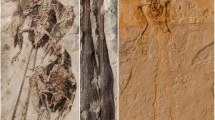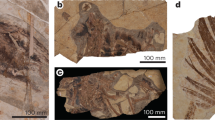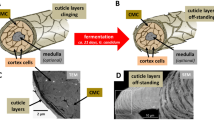Abstract
THE cuticle of an animal fibre consists of a thin membrane, the epicuticle1, covering the surface, and at least two more layers, the exo- and endo-cuticle2. The epicuticle of wool has been especially studied at this Institute, and work is now being carried out on its fine structure and chemical composition. Related subjects such as the feather vane and down from the white domestic fowl have also been examined in the electron microscope in order to see if any corresponding layers could be found.
This is a preview of subscription content, access via your institution
Access options
Subscribe to this journal
Receive 51 print issues and online access
$199.00 per year
only $3.90 per issue
Buy this article
- Purchase on Springer Link
- Instant access to full article PDF
Prices may be subject to local taxes which are calculated during checkout
Similar content being viewed by others
References
Lindberg, J., Philip, B., and Gralén, N., Nature, 162, 458 (1948).
Mercer, E. H., Lindberg, J., and Philip, B., Text. Res. J., 19, 678 (1949).
Elöd, E., and Zahn, H., Naturwiss., 33, 158 (1946).
Lundgren, H. P., Stein, A. M., Koorn, V. M., and O'Connell, R. A., J. Phys. Coll. Chem., 52, 180 (1948).
Author information
Authors and Affiliations
Rights and permissions
About this article
Cite this article
PHILIP, B., LAGERMALM, G. & GRALÉN, N. Surface Structure of Feathers from the White Domestic Fowl. Nature 166, 1070–1071 (1950). https://doi.org/10.1038/1661070a0
Issue Date:
DOI: https://doi.org/10.1038/1661070a0
This article is cited by
-
Elektronenmikroskopische Untersuchung der Einlagerung von Eisenoxid in Anatiden-Federn
Zeitschrift f�r Zellforschung und Mikroskopische Anatomie (1968)
-
Elektronenmikroskopische Untersuchung der Pigmentgranula in den schillernden Federstrahlen der Taube Columba trocaz H.
Zeitschrift für Zellforschung und Mikroskopische Anatomie (1961)
-
Occurrence of Thin Membranes in the Surface Layers of Human Skin and in Finger Nails
Nature (1951)
Comments
By submitting a comment you agree to abide by our Terms and Community Guidelines. If you find something abusive or that does not comply with our terms or guidelines please flag it as inappropriate.



